More about: Dublin in 1 Day: a guidebook for getting the most out of your visit
Are you traveling to Ireland and stopping in Dublin for 1 day? Are you making a long stopover in Dublin and don't want to miss the opportunity to visit the Irish capital? Dublin is a city brimming with attractions, although it is possible to see the essentials in just one day. Monuments, gastronomy, incredible urban environments ... All this will occupy us from morning to night and I'll show you as a proposal in chronological sequence. Come on!
Stroll along O'Connell Street
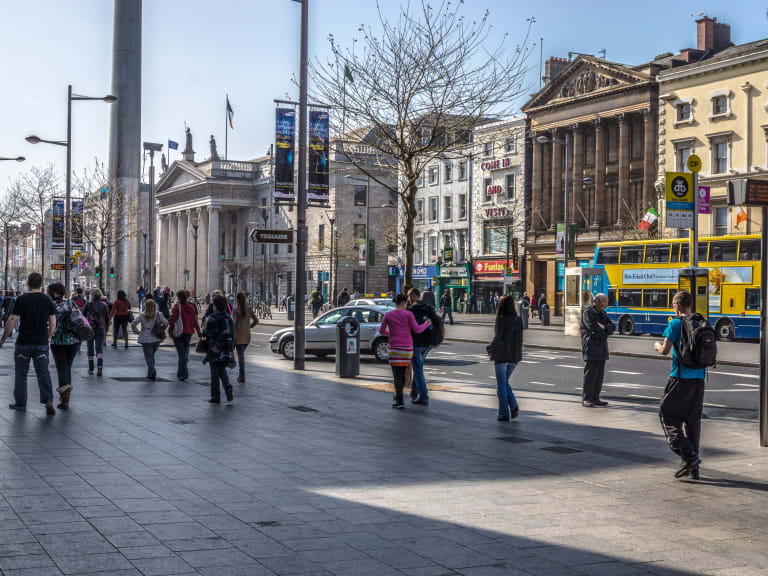
A spectacular place to start the day. It is not a very long street (just 500 meters) but it congregates a great urban life. Its sidewalks are very wide, so they are perfect for the stroller. There, in its many terraces, you can gather energy with a good breakfast. Once you have finished, head towards the Liffey River.
The O'Connell Street has several charms and curiosities. Almost all of them related to the turbulent Irish history and its independence from the United Kingdom. The most interesting are the following:
- Spire Monument: with its 120 meters, it is one of the largest urban sculptures in Europe.
- Central Post Office: a very emblematic place of Irish identity and history. It was here that the Republic of Ireland was proclaimed in 1916.
- Monuments to the heroes of independence: sculptures dedicated to the great men who were the architects of Irish independence. Highlights include those dedicated to Charles Parnell, James Larkin and Sir John Gray.
By the way, hiring a guided tour of Dublin can be a good way to approach all these landmarks. In just 1 hour and 15 minutes, and without having to worry about looking for directions.
Interesting facts
If you prefer to visit this part of the city at a different time of the day, pay close attention to the opening hours of the stores. Perhaps one of your goals is to window shop, enter the stores and even do some shopping. The opening hours in Dublin can be quite different from what we are used to in Spain. Therefore, take good note:
- Small and medium-sized stores: They are often open from Monday to Saturday between 09:00 and 18:00 hours. On Thursdays, depending on the store, they may extend their opening hours.
- Department stores: Department stores open at a similar time as the rest of the stores but close a little later, around 20:00 or 21:00 hours.
Look out over the River Liffey from O'Connell Bridge

A few minutes at a leisurely pace, O'Donnell Street will take you to the O'Donnell Bridge. Built at the end of the 18th century, it is one of the most interesting bridges in the city.
It is made of granite and has a very striking feature: the O'Connell Bridge is wider than it is long. Once you have enjoyed the view of the river, cross it and head down D'Olier Street. In a few minutes it will take you to one of the must-see sights of the city: Trinity College.
Do you feel like looking at the Liffey River from a different point of view? Book a 45-minute sightseeing cruise around Dublin that will give you a new perspective of the city's sights.
Interesting facts
and tips
If you are seduced by the idea of following this itinerary, just a few tips for you to do it in an optimal way. Especially for the issue of cold and humidity (more intense the closer we are to the river). I guide you on how to do it:
- Months from October to January: the rainiest. If you visit Dublin at this time take with you a raincoat or hooded jacket.
- November, December and January: The coldest months. Temperatures in Dublin during the winter reach a minimum of 5 degrees Celsius. Here you will need warm clothes if you don't want to freeze in the cold and damp of the river.
Visit Trinity College

Founded in the 16th century, it is the oldest university in Ireland and one of the most beautiful buildings in the city. But probably the best thing is inside. Trinity College houses the famous Book of Kells, one of the most famous medieval manuscripts for its illustrations and artistic wealth.
Its library will ring a bell. No wonder, given that Harry Potter's Hogwarts School was inspired by it. In fact, it may be one of the most famous libraries in the world for the beauty of its space, and above all for the thousands of books it holds! No more and no less than 200,000 books.
Interesting facts
Trinity College opening hours and prices are as follows:
- From May to September: Open from Monday to Saturday between 08:30 and 17:00 hours. On Sundays the opening hours are from 09:30 to 17:00 hours.
- From October to April: Open from Monday to Saturday between 09:30 and 17:00 hours and on Sundays between 12:00 and 17:00 hours.
- Prices: You can buy the ticket from 12 €.
Eat a good stew with a glass of beer

Maybe it's time to start thinking about eating something to eat. In Dublin there are many places to do it, but I am going to advise you one because of its proximity to Trinity College, the interesting itinerary that will take you there and what is more important: the opportunity it will give you to eat a good stew cooked in Guinness beer. The restaurant is the famous Landmarks.
Take South George's Street and you will arrive at the restaurant. On your itinerary you will pass the famous sculpture of Molly Malone, one of the emblems of traditional Irish culture and musical folklore. The Landmarks is a pleasure for the palate but also for the eyes, especially for the late nineteenth century building in which it is located.
Yes, I know, what I'm going to tell you now will take you a few hours, but if you are a fan of Guinness beer you should know that in Dublin you have the possibility to do an Irish beer tour with entrance to the Guinness Storehouse!
Interesting details and prices
- Opening hours: Monday to Thursday from 16:00 to 23:30 hours, Fridays and Saturdays from 15:00 to 00:30 hours and Sundays from 12:30 to 23:00 hours.
- Prices: You can have one of their stews from 12 €.
Take the food down to St Stephen's Green and see St Patrick's Cathedral
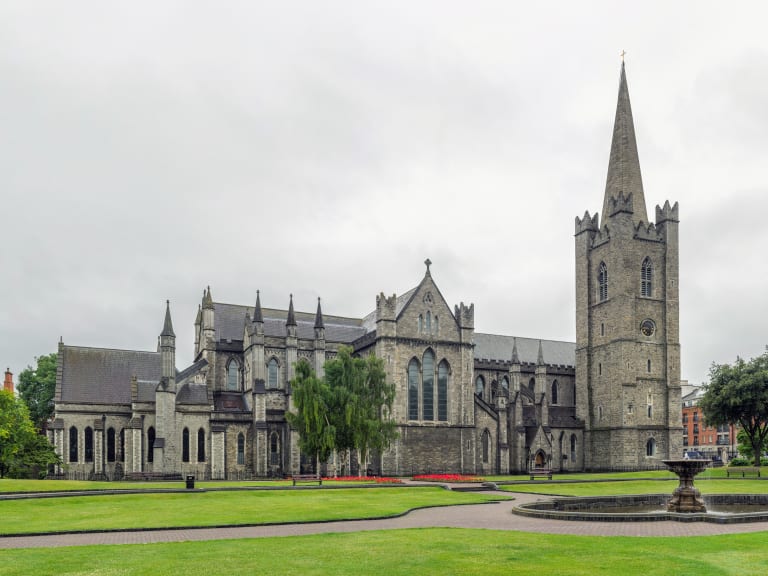
Just 5 minutes walk from Landmarks, you will find St Stephen's Green, one of the best parks in Dublin. A green extension of 9 hectares with about 3.5 km of paths and nineteenth-century style. Its most interesting places are the following:
- The memorial to James Joyce: Undoubtedly the most relevant Irish author in history.
- Memorial to Yeats: Another of Ireland's great writers, especially in the lyrical genre.
- The lake: The best place to sit for a while and enjoy the food with great views. It is located in the center of the park.
Once you have recharged your batteries, you can set off to continue exploring Dublin. More specifically Dublin Castle, located 15 minutes away. And, on the way, you can contemplate St. Patrick's Cathedral, Gothic style and one of the key places of Irish history.
Useful information
opening hours and entrance
If you have decided to visit it, in the case of St Stephens Green the entrance is totally free. As for the opening hours, they are as follows:
- Monday to Saturday: Open between 07:00 hours and sunset.
- Sundays and holidays: Open from 07:30 hours to sunset.
Regarding St. Patrick's Cathedral, these are the facts you need to know:
- Opening hours: Monday to Friday between 09:00 and 17:00 hours. On Saturdays and Sundays it has a more variable schedule depending on religious services and special liturgical events.
- Entrance fee: You can enter the Cathedral from 7 €.
See Dublin Castle
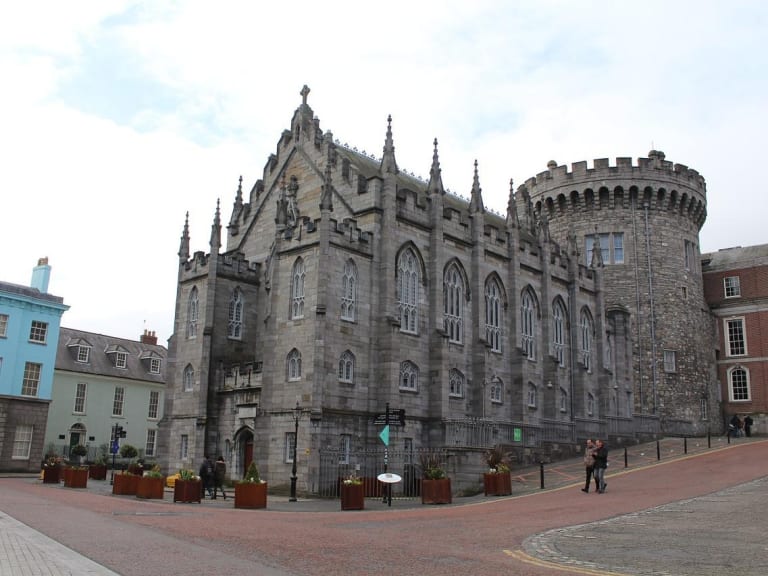
Another of the landmark monuments of the city. Especially for its historical significance, but also in the artistic is of great quality. Dublin Castle was built in the late twelfth century, although today the most medieval thing we can see is its tower. The rest has been rebuilt in an eclectic way due to its fire in the seventeenth century.
The historical interest is absolute because it summarizes in its walls centuries and centuries of Irish history. From the seat of the Viking settlement on the island to the residence of Irish royalty, Dublin Castle has been, over the centuries, incorporating each of these uses becoming a living testimony of the history of the country.
But don't just look at it from the outside. Its interior treasures a great artistic wealth. There are several rooms, although the most interesting are the following:
- Rellano de las Hachas de Guerra (War Axes Hall).
- Hall of the Throne
- Hall of James Connolly
- Room of the King and Queen
Interesting facts
If you have already decided that it is going to be one of the stops on your 1 day itinerary in Dublin, here is what you have to take into account:
- Hours: 09:45 am to 4:45 pm.
- Duration of visit: A leisurely 45 minute walk will be enough to get a good look at it.
- Price: Tickets are available from 7 €.
Another of Dublin's landmarks: the Guinness Storehouse
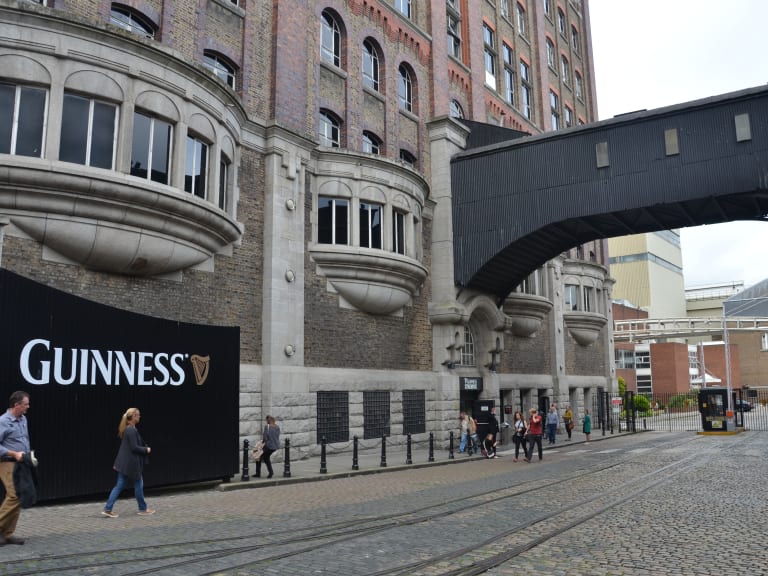
For many people the Guinness Storehouse is the real Cathedral of Dublin. It is not very central but, to get there, you have several options:
- Once you have left Dublin Castle walk about 200 meters to Lord Edward Street and take the #40 bus. Five minutes later get off at James Street and the Guinness Storehouse is just 500 meters away.
- Book a private guided tour of the Guinness Store house that includes an expert guide and a tasting of several beers.
It is a seven-story building that is the most visited landmark in Dublin. Inside you can discover the following:
- The Guinness brewing process.
- The history of the company from the 18th century to the present day.
- Examples of old and modern advertisements of the brand
- The history of the Guinness Book of Records
- An interactive tour where you will learn how to pour (and drink) a good pint.
Interesting facts
- Duration of tour: Approximately 90 minutes.
- Hours: From 09:00 to 17:00 hours in spring, autumn and winter and from 09:00 to 19:00 hours in summer.
- Prices: from 20 €.
Find a place to dine: Temple Bar, Dublin's most dynamic area
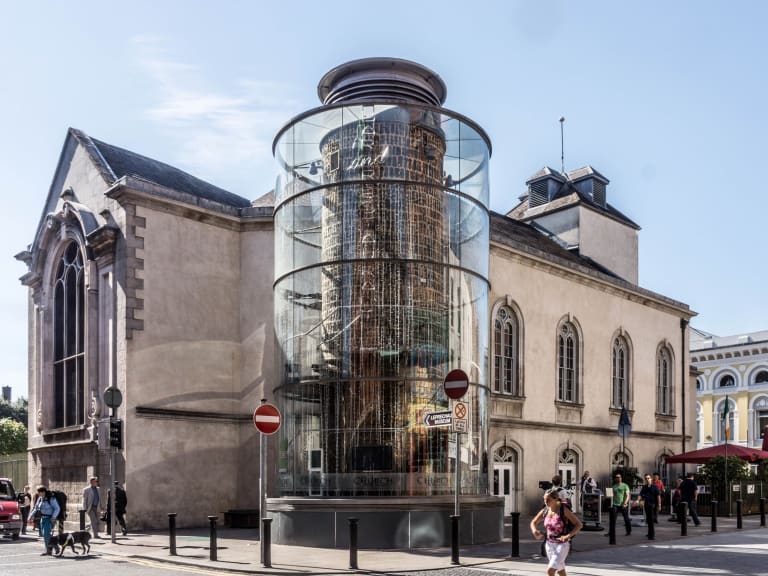
In the city center, more specifically on the river bank, is one of the most vibrant areas of Dublin: Temple Bar. A place to immerse yourself in the life of the city through its internationally famous Irish pubs. But not only that awaits you, you can also visit:
- Art galleries.
- Craft establishments.
- The Food Market.
- The Book Market.
Hunger pangs after a busy day? Perhaps booking a 4-course dinner of authentic Irish food while enjoying an Irish cabaret show at Taylors Three Rock in Dublin sounds appealing, right?
Interesting facts
and tips
If you are planning to visit the Food Market for a bite to eat, I advise you to check the opening hours. I show you everything you need to know to make your experience as optimal as possible:
- Opening day: Every Saturday.
- Hours: From 10:30 am to 4:30 pm.
- Prices: There is everything, but street food is available from 3 €.
- Most of the food is take away.
End the day with the bridges of Dublin illuminated at night

Once you've had dinner, what better way to end the day than with a stroll along the riverbank. Dublin has many bridges, so a good way to get to know them is to walk around at night.
Many of them are illuminated, as well as the buildings that overlook the riverbanks, so I can't think of a better accompaniment for a last stroll around Dublin before returning to your hotel. Options? Stroll along the riverbank.
My recommendation is that you try to see the Samuel Beckett Bridge, another of Dublin's tributes to Irish writers. It was designed by a Spaniard, Santiago Calatrava.
Interesting facts
and tips
- Duration of the walk: Approximately 30 minutes to the Samuel Beckett Bridge.
- Direction: Go out to the river from Temple Bar and head east.
Is the Dublin All-Inclusive Pass worth it?

The Dublin All-Inclusive Pass is a tourist pass which, when purchased, allows free entry to 80 of Dublin's most popular attractions. The most important are the following:
- Guinness Factory
- Dublin Zoo
- Dublinia
- Dublin Castle
- Rock and Roll Museum
- Malahide Castle
The cost of this card is from 72 € for adults and free for children under 12 years. It is a good way to save money, because it also allows access to the Big Bus tourist bus.
Definitely a great option, although it is worth calculating if it is convenient when you are only going to be 1 day in the city: select the attractions you know you are going to visit, make your own calculations and buy your All-Inclusive Dublin Pass if you think it is profitable for you.



